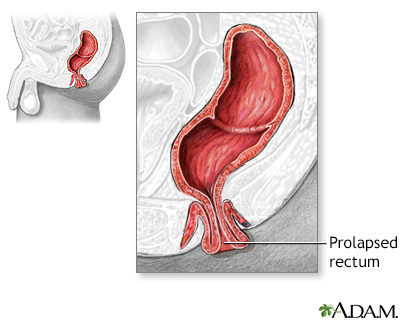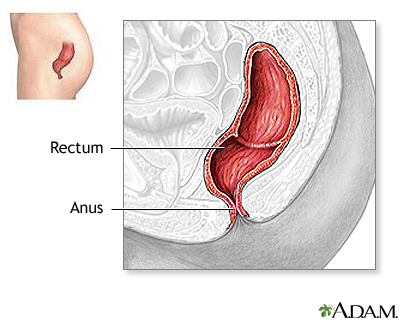Rectal prolapse
Definition
Rectal prolapse occurs when the rectum sags and comes through the anal opening.
Alternative Names
Procidentia; Rectal intussusception
Causes
The exact cause of rectal prolapse is unclear. Possible causes may include any of the following:
- An enlarged opening due to relaxed muscles in the pelvic floor, which is formed of muscles around the rectum
- Loose muscles of the anal sphincter
- An abnormally long colon
- Downward movement of the abdominal cavity between the rectum and uterus
- Prolapse of the small intestine
- Constipation
- Diarrhea
- Chronic coughing and sneezing
A prolapse can be partial or complete:
- With a partial prolapse, the inner lining of the rectum bulges partly from the anus.
- With a complete prolapse, the entire rectum bulges through the anus.
Rectal prolapse occurs most often in children under age 6. Health problems that may lead to prolapse include:
- Cystic fibrosis
- Intestinal worm infections
- Long-term diarrhea
- Other health problems present at birth
In adults, it is usually found with constipation, or with a muscle or nerve problem in the pelvic or genital area.
Symptoms
The main symptom is a reddish-colored mass that sticks out from the opening of the anus, especially after a bowel movement. This reddish mass is actually the inner lining of the rectum. It may bleed slightly and can be uncomfortable and painful.
Exams and Tests
The health care provider will perform a physical exam, which will include a rectal exam. To check for prolapse, the provider may ask the person to bear down while sitting on a toilet.
Tests that may be done include:
- Colonoscopy to confirm the diagnosis
- Blood test to check for anemia if there is bleeding from the rectum
Treatment
Call your provider if a rectal prolapse occurs.
In some cases, the prolapse can be treated at home. Follow your provider's instructions on how to do this. The rectum must be pushed back inside manually. A soft, warm, wet cloth is used to apply gentle pressure to the mass to push it back through the anal opening. The person should lie on one side in a knee-chest position before applying pressure. This position allows gravity to help put the rectum back into position.
Immediate surgery is rarely needed. In children, treating the cause often solves the problem. For example, if the cause is straining because of dry stools, laxatives may help. If the prolapse continues, surgery may be needed.
In adults, the only cure for rectal prolapse is a procedure that repairs the weakened anal sphincter and pelvic muscles.
Outlook (Prognosis)
In children, treating the cause cures rectal prolapse. In adults, surgery usually cures the prolapse.
When rectal prolapse is not treated, constipation and loss of bowel control may develop.
When to Contact a Medical Professional
Call your provider right away if there is a rectal prolapse.
Prevention
In children, treating the cause usually prevents rectal prolapse from happening again.
Gallery


References
Iturrino JC, Lembo AJ. Constipation. In: Feldman M, Friedman LS, Brandt LJ, eds. Sleisenger and Fordtran's Gastrointestinal and Liver Disease: Pathophysiology/Diagnosis/Management. 11th ed. Philadelphia, PA: Elsevier; 2021:chap 19.
Kliegman RM, St. Geme JW, Blum NJ, Shah SS, Tasker RC, Wilson KM. Surgical conditions of the anus and rectum. In: Kliegman RM, St. Geme JW, Blum NJ, Shah SS, Tasker RC, Wilson KM, eds. Nelson Textbook of Pediatrics. 21st ed. Philadelphia, PA: Elsevier; 2020:chap 371.
Madoff RD, Melton-Meaux GB. Diseases of the rectum and anus. In: Goldman L, Schafer AI, eds. Goldman-Cecil Medicine. 26th ed. Philadelphia, PA: Elsevier; 2020:chap 136.
